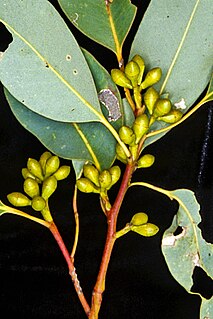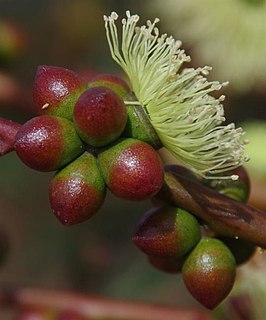
Eucalyptus tenella, commonly known as narrow-leaved stringybark, is a species of small to medium-sized tree that is endemic to New South Wales. It has stringy bark, narrow lance-shaped to linear leaves, flower buds in group of seven to fifteen, white flowers and hemispherical fruit.
Eucalyptus vicina, commonly known as the Manara Hills red gum, is a species of mallee in the family Myrtaceae and is endemic to western New South Wales. It has smooth bark, lance-shaped to curved adult leaves, flower buds in groups of seven, white flowers and cup-shaped or hemispherical fruit.
Eucalyptus quinniorum, commonly known as monkey gum, is a species of mallee or a small to medium-sized tree that is endemic to northern New South Wales. It has smooth bark with persistent, stringy bark near the base, linear to narrow lance-shaped adult leaves, flower buds in groups of seven, white flowers and hemispherical to cylindrical fruit.

Eucalyptus comitae-vallis, commonly known as Comet Vale mallee, is a mallee that is endemic to the south-west of Western Australia. It has rough, flaky to ribbony bark on the trunk and larger branches, smooth withish bark above, linear to narrow lance-shaped adult leaves, flower buds in groups of seven to eleven, white flowers and barrel-shaped, conical or cup-shaped fruit.
Eucalyptus blaxellii, commonly known as the Howatharra mallee, is a mallee that is endemic to Western Australia. It has smooth bark, linear to narrow lance-shaped adult leaves, flower buds arranged in groups of seven, white flowers and cup-shaped to conical fruit.

Eucalyptus effusa, commonly known as rough-barked gimlet, is a species of mallee or small tree that is endemic to Western Australia. It has thin, rough bark on the base of the trunk, smooth bark above, linear to narrow lance-shaped adult leaves, flower buds arranged in groups of seven, white flowers and cup-shaped to conical fruit.
Eucalyptus laevis is a species of mallee or tree that is endemic to Western Australia. It has thin, rough, fibrous or flaky bark on the trunk, smooth bark above. Its adult leaves are linear to narrow lance-shaped, the flower buds are arranged in groups of between seven and eleven, the flowers are white and the fruit is cylindrical to barrel-shaped.
Eucalyptus planipes is a species of mallee that is endemic to Western Australia. It has smooth bark, lance-shaped adult leaves, flower buds in groups of three and conical fruit.
Eucalyptus semota, commonly known as marymia mallee, is a species of mallee or small tree that is endemic to a small area in central Western Australia. It has rough, flaky to fibrous bark on the trunk, smooth grey or brown bark above, linear to narrow lance-shaped leaves, flower buds in groups of seven or nine, white flowers and conical to cup-shaped fruit.
Eucalyptus ultima is a species of mallee that is endemic to a small area in the Gascoyne region of Western Australia. It has smooth bark, linear to narrow lance-shaped leaves, flower buds in groups of nine to fifteen, white flowers and spherical to cup-shaped fruit.
Eucalyptus vegrandis, commonly known as the Ongerup mallee, is a species of mallee that is endemic to the south-west of Western Australia. It has smooth bark, linear to lance-shaped adult leaves, flower buds in groups of seven, creamy white flowers and cup-shaped or conical fruit.
Corymbia arnhemensis, commonly known as the Katherine Gorge bloodwood, is a species of slender tree that is endemic to the Top End of the Northern Territory. It has rough bark on some or all of the trunk, sometimes the larger branches, smooth bark above, lance-shaped to curved adult leaves, flower buds in groups of seven, white flowers and urn-shaped fruit.
Eucalyptus delicata is a species of tree that is endemic to Western Australia. It has rough, fibrous to scaly bark on the trunk, smooth white to greyish bark above, linear to narrow lance-shaped adult leaves, flower buds in groups of between seven and eleven, creamy white flowers and more or less spherical to barrel-shaped fruit.
Eucalyptus foliosa is a species of mallee that is endemic to Western Australia. It has a dense crown with foliage reaching to the ground, smooth greyish bark, linear to narrow lance-shaped or narrow oblong adult leaves, flower buds in groups of seven or nine, white flowers and conical to shortened hemispherical fruit. It is only known from a small area near Esperance.
Eucalyptus gigantangion, commonly known as Kakadu woollybutt, is a species of tree that is endemic to the Northern Territory. It has soft, fibrous bark most of the trunk, smooth white bark above, narrow lance-shaped adult leaves, flower buds in groups of seven, orange-coloured flowers and ribbed, urn-shaped fruit.

Eucalyptus grisea, commonly known as grey gum, is a species of tree that is endemic to central Queensland. It has smooth greyish bark, lance-shaped to egg-shaped adult leaves, flower buds in groups of seven, white flower and usually cup-shaped fruit.

Eucalyptus helidonica is a species of tree that is endemic to an area near Helidon in Queensland. It has rough, finely fibrous bark, lance-shaped or curved adult leaves that are paler on the lower surface, flower buds in groups of eleven or more, white flowers and shortened spherical or barrel-shaped fruit.
Eucalyptus persistens is a species of small tree that is endemic to Queensland. It has rough, dark grey bark, lance-shaped adult leaves, flower buds in groups of seven, white flowers and cup-shaped or barrel-shaped fruit.

Eucalyptus terebra, commonly known as Balladonia gimlet, is a species of gimlet that is endemic to Western Australia. It has satiny or glossy bark on its fluted trunk, linear to narrow lance-shaped adult leaves, flower buds in groups of seven, yellowish flowers and conical to hemispherical fruit. It is one of the seven species of gimlet.
Eucalyptus alipes is a mallet that is endemic to the south-west of Western Australia. It has smooth grey to light brown or bronze bark, linear to narrow elliptic leaves, oval to spindle-shaped buds with a long, narrow operculum and conical fruits.





